
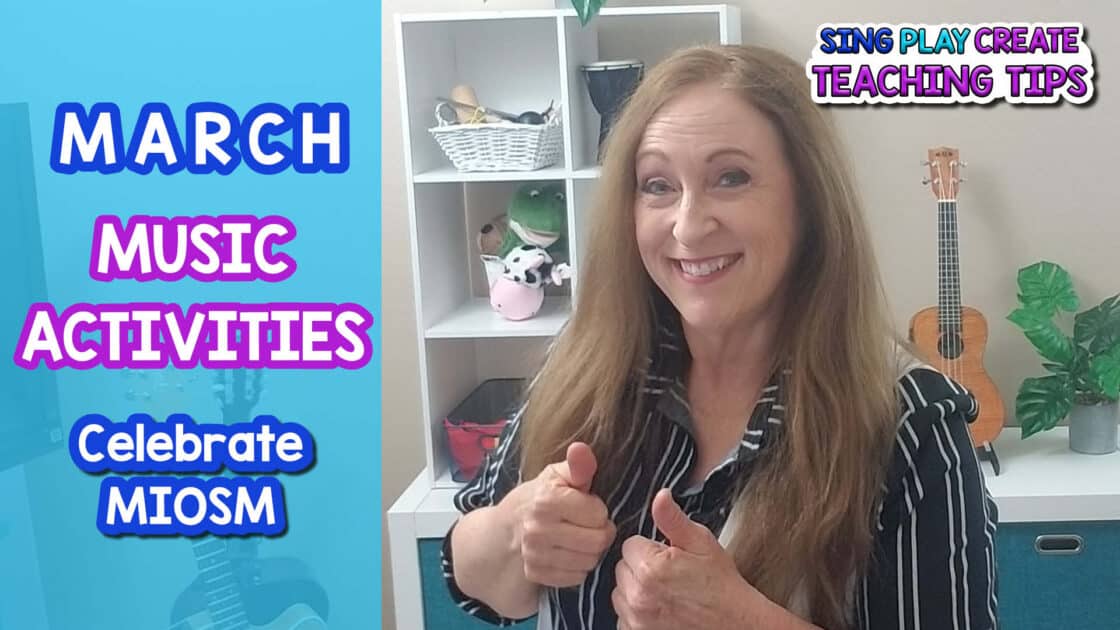
MIOSM Music in Our Schools Month Activities is sponsored by NAfME. The NAfME provides many activities elementary music teachers can use in their classrooms and school. Every year during the month of march music teachers provide special opportunities in their schools to advocate for music education.
The theme for 2023 is MUSIC IS ALL OF US!
What a wonderful theme to help everyone around the world connect through music.
So, I’m sharing some ways to celebrate MIOSM in elementary schools using the theme MUSIC IS ALL OF US.
There is a FREE PRESENTATION with all of these ideas and directions in the Sing Play Create FREE RESOURCE LIBRARY.
Another way to celebrate music in our schools is to schedule some informal concerts with upper elementary students singing.
You may want to chose an easy song to sing about friendship.
I wrote this one that works well for Kindergarten and First Grade.
“Everyone Can Be A Friend” through Music!
You may want to hold a School wide sing along or, a formal concert with selections from several grade levels.
The more people involved in the celebration the better!
I wrote A recorder song ‘MUSIC ROCKS’ DOWNLOAD HERE
And you can get a FREE SONG FOR MIOSM: “MARCH IS MUSIC MONTH”
Hold a song writing competition or have students in your classes write a chant.
Post these chants/songs/raps on a bulletin board.
Brain storm with your students and have them work in small groups to compose songs.
Freebie Music in Schools “March is Music Month”, “We Love Music” SSA ACAPELLA
In addition, you can use any student work to create a bulletin board.
I typically had my students make the bulletin boards. Have them make large MIOSM letters on the butcher paper and then you can post other student work underneath the letters.
HAVE STUDENTS DESCRIBE “MUSIC IS ALL OF US” through artwork or writing.
Alternatively, you can use some of these FREE writing and poster activities on a bulletin board.
NO NEED FOR PAPER IF YOU WANT TO DO A SIMPLE ACTIVITY- THIS IS IT.
Pull together a few pieces of music you want students to listen to.
Write the questions you want them to answer on the board.
Ask questions like:
Have them listen to the music and then share ideas about “THERE IS MUSIC IN US ALL”
You can have a lot of fun using these questions in your classroom.
One thing I do is to have my students share their ideas with each other instead of a whole group discussion. It’s called PAIR AND SHARE.
I’ll have them all stand up and I’ll say; “Find one person to share one idea.
When you hear the drum, switch.” I’ll do this three times.
I walk around the room and listen in on what students are saying.
The students love to talk and this is a fun way for them to share their feelings.
I might even have a couple of them write their ideas on the board.
One way to help students learn about music in all of us is to experience different styles of music. It’s also important to share historical and cultural background. It’s fun to dance, but we also want to learn about the music and the dance.
I’ve selected several different styles to share in this post, and there is another FREE RESOURCES which has more dance style activities. Sing Play Create FREE RESOURCE LIBRARY.
I’m not a “dancer” and so I’ve modified the dance steps to make them easy to teach and do in one class time.
The first music style activity is learning about the WALTZ.
A waltz has three beats per measure with a strong downbeat and two weak beats.
The waltz is the oldest of the current western ballroom dances. The first waltzes appeared in the 13th century in Germany and Austria. It started out an a commoners dance and gained popularity in the 19th century when (the son) Johann Strauss composed many waltzes. The most famous is the “Danube Waltz”.
Here’s a YouTube Video with Waltz music.
Have students practice playing the strong and weak beats using body percussion.
Use these options with different grade levels. All can begin with option #1 and then you can try the other options depending on how your students do during option #1.
OPTION #1
OPTION #2
Take it up a level for upper elementary students then have them do partner activities.
Create a 3 beat pattern using body percussion/movement.
STOMP SNAP PAT ACROSS
OPTION #3 CIRCLE
OPTION #4
You can pair this activity with some 3 beat songs too.
“The More We Get Together” is a great 3 beat clapping game and works so well with the theme MUSIC IS US ALL.
“Oh Where, Oh where has my little dog gone?” is also fun three beat song.
Oh where, oh where has my little dog gone?
Oh where, oh where can he be?
With his ears cut short and his tail cut long.
Oh where, oh where can he be?
I’m not a dance expert, but I like to try dancing with my students. You may have some dancers in your classes that can help with these actions.
Try listing the actions and then doing each of them for 8 beats.
You can use songs from the Jazz period.
One of my favorites is ELLA FITZGERALD SINGING “IT DON’T MEAN A THING (IF IT AIN’T GOT THAT SWING) by Duke Ellington
ELLA FITZGERALD SINGING “IT DON’T MEAN A THING (IF IT AIN’T GOT THAT SWING)
Ed Sullivan Show 1965
I would have the students practice the patterns to a slow beat to get used to them and then do it with the music.
There are links to YouTube videos of the music in the FREE RESOURCE.
Here’s an easy set of actions you can use for any jazz music.
Do each action for 8 beats.
Hands on hips, jump legs in and out- like jumping jacks but no arms.
Jazz hands: Spread fingers out and shake your hands out in front of you moving right, left, right, left. You can alternate pointing toes out if possible, or just bend knees on the beat.
Hands on hips. Cross step r over l, l behind right. Switch and return to spot.
Place arms at sides but point hands out (like a penguin walk).
Walk in a circle for the 8 beats.
Practice each action as long as needed.
Then put 2 actions together one after the other- then add the 3rd and finally do all four in a row to the music.
You can do an easy version of the Cha Cha
Step- Step- cha cha cha
ta ta ti ti ta
I really like this dance workout that is perfect for students to learn about the CHA CHA.
CHA CHA KIDS WORKOUT DANCE
Here’s a Link to some CULTURAL information that would be nice to use in a music lesson.
Formation: Students can stand in two concentric circles or stand anywhere in the room facing a partner.
(I have adapted the lyrics)
A
La Raspa I will dance as forward and back I go.
So if you want to dance, begin with your heel and toe.
B
JUMP and JUMP and JUMP
MOVE and MOVE here and there!
La Raspa you will dance,
To the right and then reverse.
Section A
Section C (Stand facing partner, hands behind backs)
• 8 beats: 4 steps forward, 4 steps back
(Repeat pattern until next section)
Section A1
Most of all, take it slowly and have the students enjoy the experience.
It’s important to know that this traditional song from Mexico is special to Hispanic people and is to be respected.
MIOSM Music in Our Schools Month Activities is sponsored by NAfME.
“Music teachers celebrate MIOSM® in many ways by offering special performances, lessons, sing-alongs and activities to bring their music programs to the attention of administrators, parents, colleagues, and communities to display the positive benefits that school music brings to students of all ages.
NAfME provides many special resources for teachers and schools to use in their concerts, lessons, and advocacy events that highlight the importance of school music.“
I hope you got some ideas for your music classes from this article.
More March music and movement activities: MARCH ST. PATRICK’S DAY MUSIC ACTIVITIES
Let’s move and learn with music!

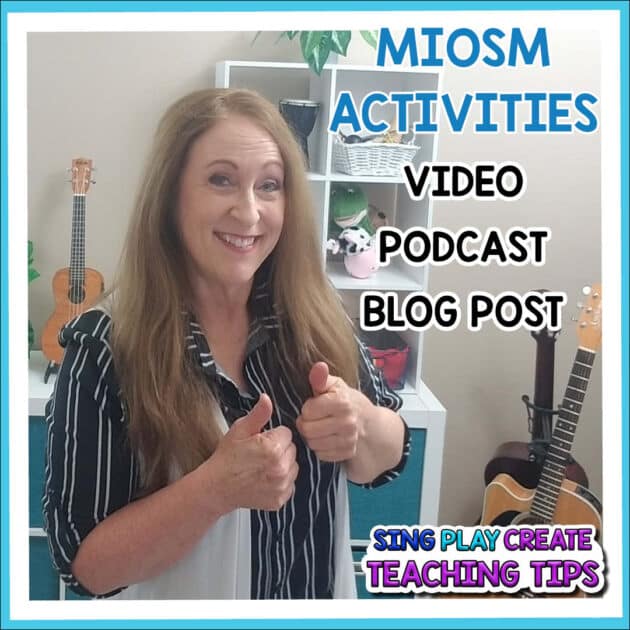
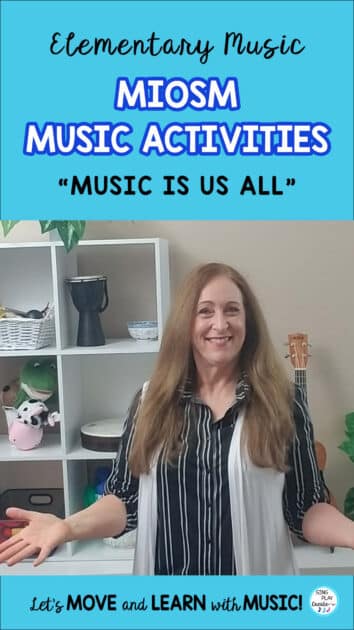
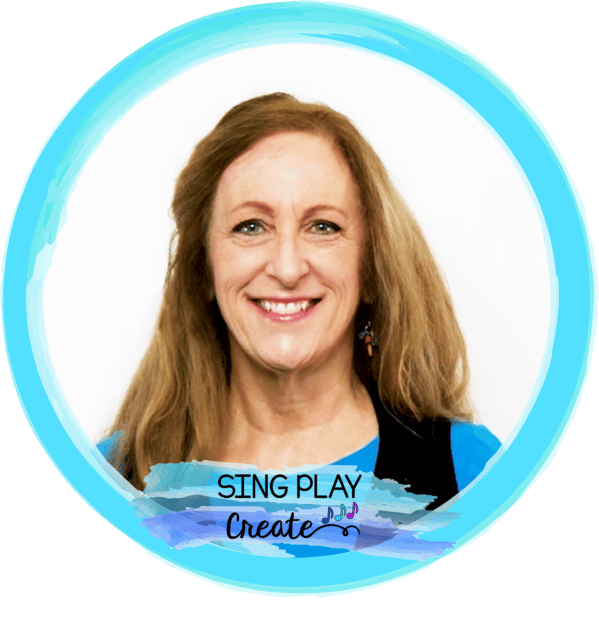
Hi there! I’m Sandra, one of the authors behind Sing Play Create. My goal is to provide teachers with interactive resources and activities to improve the effectiveness of their teaching and enhance student learning.
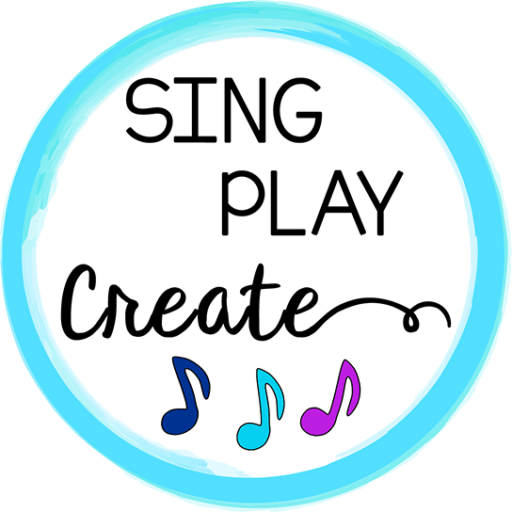
© 2022 Sing Play Create. All Rights Reserved.